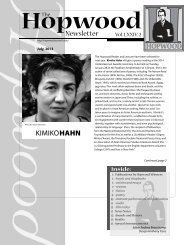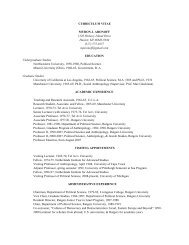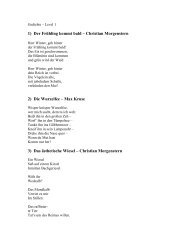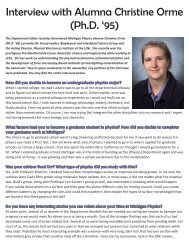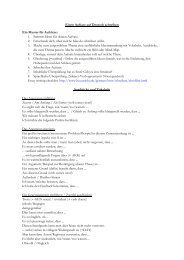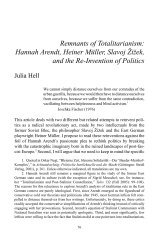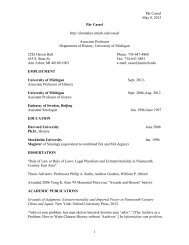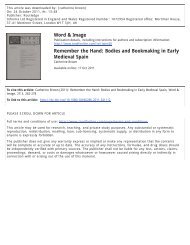History of Art - College of Literature, Science, and the Arts ...
History of Art - College of Literature, Science, and the Arts ...
History of Art - College of Literature, Science, and the Arts ...
Create successful ePaper yourself
Turn your PDF publications into a flip-book with our unique Google optimized e-Paper software.
4<br />
Pr<strong>of</strong>essor Martin Powers <strong>and</strong> H. Christopher Luce<br />
Inaugural Charles Lang Freer Lecture:<br />
U-M <strong>History</strong> <strong>of</strong> <strong>Art</strong>’s Enduring Relationship with <strong>the</strong> Freer Gallery <strong>of</strong> <strong>Art</strong><br />
When Detroit industrialist <strong>and</strong> connoisseur Charles Lang Freer<br />
donated his collection <strong>of</strong> Asian antiquities <strong>and</strong> contemporary<br />
American art <strong>of</strong> <strong>the</strong> Aes<strong>the</strong>tic Movement to <strong>the</strong> nation in 1906, he<br />
was fired by a gr<strong>and</strong> vision: a public museum in <strong>the</strong> capital—<strong>the</strong><br />
first art museum <strong>of</strong> <strong>the</strong> Smithsonian Institution—that would enable<br />
Americans, amateurs, <strong>and</strong> experts alike to appreciate beauty <strong>and</strong><br />
underst<strong>and</strong> civilizations through art. Like James McNeill Whistler,<br />
<strong>the</strong> expatriate American who encouraged Freer’s interest in <strong>the</strong> arts<br />
<strong>of</strong> Asia, Freer believed that <strong>the</strong> aes<strong>the</strong>tic harmonies he discerned<br />
among <strong>the</strong> diverse objects in his collection were evidence <strong>of</strong> a<br />
transcendent, timeless, <strong>and</strong> universally valid “story <strong>of</strong> <strong>the</strong> beautiful.”<br />
Since opening to <strong>the</strong> public in 1923, <strong>the</strong> Freer Gallery <strong>of</strong> <strong>Art</strong><br />
has maintained Freer’s legacy through collecting, connoisseurship,<br />
<strong>and</strong> promotion <strong>of</strong> scholarly activity. The Freer’s enduring<br />
relationship with <strong>the</strong> University <strong>of</strong> Michigan, which includes <strong>the</strong> copublication<br />
<strong>of</strong> <strong>the</strong> journal Ars Orientalis <strong>and</strong> an endowed graduate<br />
fellowship, has nurtured several generations <strong>of</strong> intellectual inquiry<br />
<strong>and</strong> created networks <strong>of</strong> interpretation for an ever-widening field <strong>of</strong><br />
Asian art history <strong>and</strong> visual culture.<br />
The most recent component <strong>of</strong> this relationship is <strong>the</strong> Charles<br />
Lang Freer Lecture, which aims to encourage a broad-spectrum<br />
dialogue on <strong>the</strong> arts <strong>of</strong> Asia in keeping with <strong>the</strong> larger m<strong>and</strong>ate<br />
<strong>of</strong> <strong>the</strong> Freer bequest. Through engagement with outst<strong>and</strong>ing<br />
speakers from all corners <strong>of</strong> <strong>the</strong> art world, <strong>the</strong> series will foster fresh<br />
perspectives on <strong>the</strong> arts <strong>and</strong> Asia in <strong>the</strong> twenty-first century.<br />
The inaugural lecture, held in Ann Arbor in February, featured<br />
H. Christopher Luce. In “Chinese Calligraphy: Seeing an Ancient<br />
<strong>Art</strong> through Modern Eyes,” Luce <strong>of</strong>fered fresh insight into <strong>the</strong><br />
relationship between <strong>the</strong> ancient <strong>and</strong> <strong>the</strong> modern. A collector <strong>of</strong><br />
Chinese <strong>and</strong> Japanese painting <strong>and</strong> calligraphy, as well as American<br />
photography, Luce attended Yale University, where he studied<br />
photography with Walker Evans <strong>and</strong> pursued his interest in Asia by<br />
designing a final year <strong>of</strong> research in Chinese art <strong>and</strong> philosophy. This<br />
focus on visual representation is also reflected in his pr<strong>of</strong>essional<br />
career, in which he was a prize-winning photojournalist. He<br />
returned to academia to study East Asian languages <strong>and</strong> arts<br />
at Harvard University. Subsequently, he worked in <strong>the</strong> world <strong>of</strong><br />
philanthropy, initiating programs to protect <strong>the</strong> environment <strong>and</strong><br />
to support projects in <strong>the</strong> visual arts. He is currently director <strong>of</strong> <strong>the</strong><br />
board at <strong>the</strong> Henry Luce Foundation.<br />
In his capacity as a scholar <strong>and</strong> collector, Luce has curated<br />
such exhibitions as “Abstraction <strong>and</strong> Expression in Chinese<br />
Calligraphy” <strong>and</strong> “A Literati Life in <strong>the</strong> Twentieth Century,” both at<br />
<strong>the</strong> China Institute in America; <strong>and</strong> “The Dancing Brush: Chinese<br />
<strong>and</strong> Japanese Calligraphy” at <strong>the</strong> Yale University <strong>Art</strong> Gallery. He has<br />
edited exhibition catalogs, written articles, <strong>and</strong> lectured widely on<br />
Chinese art. He is currently developing an exhibition on “The Word<br />
as Image” for Wooster in which he emphasizes <strong>the</strong> primacy <strong>of</strong> <strong>the</strong><br />
visual image <strong>and</strong> <strong>the</strong>ir connections across cultures.<br />
Co-sponsored by <strong>the</strong> Confucius Institute at <strong>the</strong> University <strong>of</strong> Michigan



